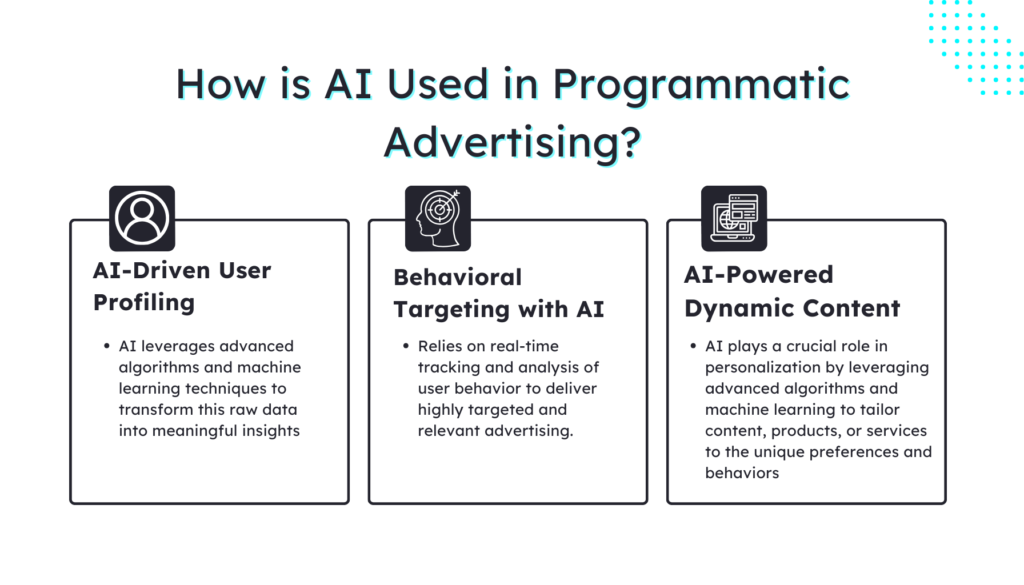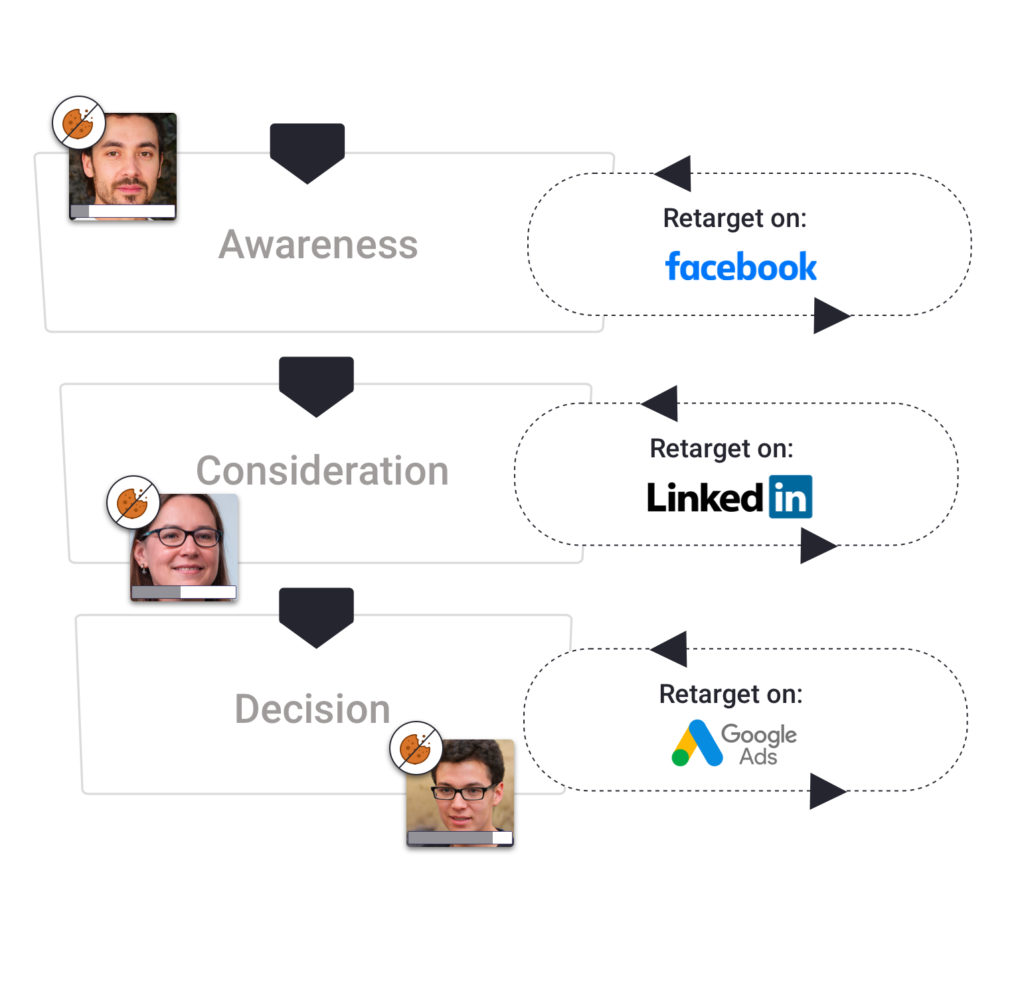AI-Powered Programmatic Advertising for Highly Personalized, Targeted Campaigns


Programmatic advertising, with its real-time bidding and automated ad placement, has revolutionized the way brands connect with their audience. It is a technology-driven approach that ensures ads reach the right users at the right time, maximizing the chances of engagement and conversion.
However, the true magic happens when AI is infused into this process, enabling a level of personalization and precision that was once thought to be unattainable.
Table of Contents
What is Programmatic Advertising?
Programmatic advertising is a highly automated and data-driven approach to buying and optimizing digital advertising. It involves the use of technology, algorithms, and real-time bidding to purchase and place ads on various digital platforms. The goal of programmatic advertising is to deliver highly targeted and personalized ads to the right audience at the right time, optimizing ad spend and maximizing campaign effectiveness.
As the focus of this post is to explore how AI enhances programmatic advertising, we’ll only briefly mention the key components and concepts of this type of advertising:
- Real-Time Bidding (RTB): Programmatic advertising often involves real-time auctions, where advertisers bid for ad impressions in the milliseconds it takes for a webpage to load. Advertisers set specific targeting parameters, and the highest bidder’s ad is displayed to the user.
- Data-Driven Targeting: Programmatic advertising relies on a wealth of user data and machine learning algorithms to target ads. This includes data such as user behavior, demographics, interests, and more.
- Ad Exchanges: Ad exchanges are platforms where publishers (websites or apps) and advertisers come together to buy and sell ad inventory in real time. Advertisers bid on impressions, and the winning ad is displayed to the user.
- Ad Inventory: This refers to the available space on websites or apps where ads can be displayed. Advertisers seek to purchase ad inventory that aligns with their target audience.
- Dynamic Creatives: Programmatic advertising allows for the dynamic customization of ad creatives in real time. This means that the content of the ad, including text and images, can be tailored to each user’s preferences or context.
Programmatic advertising offers several advantages, including efficient ad spending, the ability to reach highly specific audiences, and the automation of many time-consuming tasks associated with traditional advertising. It has become a dominant force in the digital advertising landscape, revolutionizing how ads are bought and delivered to users on the internet.
How is AI Used in Programmatic Advertising?
The integration of AI into programmatic advertising transforms it from a simple, automated ad placement process into a dynamic, personalized marketing powerhouse. The resulting campaigns are not just more efficient but also provide a superior user experience, ensuring that every ad impression counts as an opportunity to connect with and engage the audience on a deeper level.
These are some of the ways AI is revolutionizing traditional programmatic advertising:
1. AI-Driven User Profiling
AI-driven user profiling is at the heart of personalized programmatic advertising. These profiles serve as the foundation for delivering relevant content to users.
The process of creating detailed user profiles involves collecting, processing, and analyzing an extensive array of data points. AI leverages advanced algorithms and machine learning techniques to transform this raw data into meaningful insights:
- Data Collection: AI systems begin by collecting various types of data, including browsing history, search queries, social media interactions, location data, and more. This data can originate from multiple sources, such as websites, mobile apps, and online platforms.
- Data Processing: Once the data is gathered, AI systems process and cleanse it to remove irrelevant or redundant information. This step ensures that the data remains accurate and relevant for profiling.
- Pattern Recognition: Machine learning algorithms come into play to recognize patterns in the data. These patterns can encompass a user’s online behavior, content consumption, purchase history, and even the time of day they are most active online.
- Segmentation: AI clusters users into segments based on similarities in their data profiles. For instance, users who frequently search for sports-related content might be grouped.
- Predictive Analytics: AI can go a step further by using predictive analytics to anticipate a user’s future behavior. This may include predicting what products a user is likely to be interested in, which can guide ad targeting.
2. Behavioral Targeting with AI
Behavioral targeting relies on real-time tracking and analysis of user behavior to deliver highly targeted and relevant advertising.
Once user profiles are completed and dynamically updated, ensuring that they remain accurate and reflective of the user’s current interests, the programmatic system cross-references the user’s profile with available ads. When an ad placement opportunity arises, it selects the ad that is most likely to resonate with the user’s current behavior and interests.
If the ad placement is through real-time bidding (RTB), advertisers submit bids to have their ads displayed to the user. The highest bidder wins the auction, and the ad is served to the user in real time.
Behavioral targeting can also be used to control ad frequency. If a user has interacted with a particular ad several times in a short period, the system can limit further exposure to prevent ad fatigue and irritation.
When users enter a specific geographic area, such as a shopping mall, behavioral targeting can trigger location-based ads for nearby stores or special promotions. This approach leverages both behavioral and location data for highly relevant ad delivery.
Behavioral targeting manifests in various ways across the digital advertising landscape. Here are some practical examples:
- eCommerce Recommendations: Consider a user who frequently shops for athletic wear online. Behavioral targeting algorithms recognize this behavior and suggest relevant products when the user visits an eCommerce site. For example, they may receive personalized recommendations for running shoes, sportswear, or fitness equipment.
- Dynamic Retargeting: If a user recently browsed a specific product but did not make a purchase, behavioral targeting can retarget them with ads showcasing the exact product they viewed. This encourages users to revisit the site and complete the purchase.
- Content Personalization: A user who regularly reads technology-related articles might encounter ads for the latest gadgets, tech events, or software subscriptions. These ads align with the user’s demonstrated interest in technology content.
- Contextual Advertising: If a user is actively searching for vacation destinations and hotels, behavioral targeting can display travel-related ads, such as flight deals, accommodation options, or tour packages. The ad content aligns with the user’s current interest and search intent.

3. AI-Powered Dynamic Content Personalization
Dynamic content personalization is the art of tailoring ad content to individual users in real time, making it one of the most impactful aspects of programmatic advertising. But, how can AI help with personalization?
AI plays a crucial role in personalization by leveraging advanced algorithms and machine learning to tailor content, products, or services to the unique preferences and behaviors of individual users.
This process involves several key elements:
- Real-Time Analysis: AI algorithms continuously analyze the incoming data in real time. They assess user behavior, predict preferences, and determine the best way to engage the user effectively.
- Content Variation: Advertisers create multiple versions of ad content, such as different headlines, images, or calls to action. These variations are designed to cater to different user segments or personas.
- Ad Customization: Based on the insights gathered from real-time data analysis, the AI system selects the most suitable ad content variation for a particular user. This selection aligns with the user’s current context and preferences.
- Real-Time Delivery: The chosen ad variation is delivered to the user in real time. This ensures that the content is the most relevant and engaging for the user at that particular moment.
Dynamic content personalization significantly elevates user engagement and contributes to the overall success of programmatic advertising:
- By delivering content that matches a user’s interests and current online activities, dynamic content personalization ensures that the user finds the ad relevant. This relevance increases the chances of user interaction.
- Users are more likely to engage with ads that change frequently. Dynamic content keeps the ad experience fresh and exciting, preventing ad fatigue and improving user engagement.
- Users are more inclined to engage with ads that feel like they were created just for them. Dynamic content personalization strengthens the personal connection between users and brands.
- Customizing ad content in real-time, so it’s most appealing to a user’s current interests, typically results in higher click-through rates. Users are more likely to click on an ad that resonates with their immediate needs.
- Dynamic content personalization enhances the user experience by ensuring that users see content that is contextually relevant to them. This results in a more enjoyable online journey.
Users who engage with personalized and engaging ad content are more likely to convert, whether that means making a purchase, signing up for a newsletter, or taking some other desired action.
Synergy Between Programmatic Advertising and AI
As we have just explored, programmatic advertising and AI are a match made in digital marketing heaven. Programmatic advertising, with its real-time bidding, automated ad placements, and data-driven decision-making, forms the perfect framework for AI to flourish.
Here’s why they work so well together:
- Real-Time Decision-Making: Programmatic advertising relies on real-time decision-making to place ads in front of the right audience at the right moment. AI’s ability to process vast amounts of data quickly and make predictions in real time enhances programmatic advertising’s core functions.
- Efficiency and Scale: Programmatic advertising often involves managing a large number of ad impressions across multiple platforms simultaneously. AI automates the process of analyzing and optimizing these impressions, making it feasible to run large-scale, highly personalized campaigns.
- User-Centric Approach: AI’s user profiling and personalization capabilities align perfectly with programmatic advertising’s objective of delivering user-centric campaigns. Together, they ensure that each user interaction is treated as an opportunity to connect on a deeper, more personalized level.
- Data-Driven Insights: AI in programmatic advertising generates valuable insights about user behaviors and campaign performance. This data-driven approach enables marketers to refine their strategies and maximize ROI.
Cookieless Cross-Channel Advertising
Cross-channel advertising is the art of reaching users with personalized messages consistently across various digital platforms and channels. Though not necessarily AI-driven, it ensures that users encounter a cohesive and unified brand message, enhancing their overall experience, all without relying on cookies.
Pathmonk Retargeting enables marketers to run personalized intent-based retargeting campaigns that promote:
- Brand Cohesion: Consistency in personalized messages is essential for maintaining brand cohesion. When users encounter the same message or content across different channels, it reinforces the brand identity and helps users remember and trust the brand.
- Optimized Engagement: Users appreciate personalization, and consistency in personalized messaging across channels maximizes user engagement. It ensures that users have a coherent experience, regardless of where they interact with the brand.
- Multi-Touchpoint Awareness: Users often engage with brands through multiple touchpoints, from websites and apps to email and social media. Delivering consistent personalized messages helps build awareness and recognition across these touchpoints.
Supercharge your ads' ROI without cookies
Boost your ads performance with cookie-free ads that retargets users based on their real-time intent.

Conclusion
Through AI-driven user profiling, behavioral targeting, recommendation engines, dynamic content personalization, and cookieless cross-channel advertising, programmatic advertising is forging a path toward more meaningful and relevant interactions between brands and their audiences.
As we continue down this path, it’s essential to navigate ethically and responsibly. User privacy and data protection are paramount, and the industry is adapting to evolving regulations and user expectations. In doing so, advertisers are building not only personalized campaigns but also trust and goodwill with their audiences.
In this era of personalization, the lines between advertising and meaningful content blur, transforming each ad impression into an opportunity for a memorable and valuable connection. AI-powered programmatic advertising promises a new era of user-centric advertising, where the right message finds the right person at the right time.





